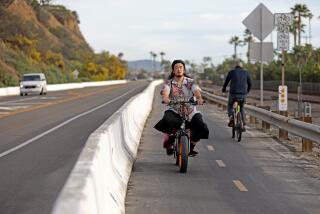Cash Incentive Keeps Commuters Out of Their Cars
- Share via
After paying out dozens of $200 daily cash prizes over the last three months, Santa Barbara city officials say they have driven a modest number of downtown commuters out of their cars--and to such alternatives as walking, cycling and skateboarding to work.
The “Try Something New” program, which began in January and ends in June, has at least begun to address crowding on streets and lack of parking in the increasingly congested downtown, city officials said.
Each day, an estimated 30 fewer cars are coming to the area and many others have become more conscious of their driving habits, according to Mindy Norris, administrator of the program.
But even some workers who have won the $200 prizes said they believe some workers will simply revert to their cars once the promotion is over.
Santa Barbara officials launched the unusual program because of the growing traffic in the shopping district around State Street and, in particular, fierce competition for parking spaces.
Exacerbating the problem is a 75-minute limit on street-side parking, which means that workers who park on the street have to move their cars several times throughout the day. The routine has come to be known by workers in the beach city as the “75-minute shuffle.”
“It’s about taking small steps in reducing the amount of cars to downtown Santa Barbara,” Norris said. “It has brought the issue to the forefront.”
City officials decided they would ask downtown workers to use alternative modes of transportation to reach their jobs and record the shifts in a journal. A work supervisor is required to sign the logs for verification, before it’s turned over to Traffic Solutions, the agency that administers the program.
For each day they use an alternative mode of transportation, commuters’ names are entered into a drawing for $200.
Currently, 110 employers and 717 individual employees have signed up. The three most popular alternative modes are carpooling, walking and bike riding, although a few participants reported gliding to work on in-line skates or riding skateboards.
Because it is open to those who took advantage of alternatives even before the contest began, not every winner represents a new reduction in motor vehicle use. But Norris expects that to change.
“People are asking, ‘How are you winning that money? What can I do [to win]?’” she said. “So more people who aren’t always using alternative transportation are signing up.”
In addition to traffic reduction, George Gerth, Santa Barbara’s manager of downtown parking, said that the program has been successful in another vital way--collecting information.
“Understanding employee commuting habits will help us plan transit and parking services in the future,” Gerth said. “We can almost customize services to be more attractive.”
Surveys from the contests have taught the city that many workers live within eight miles of downtown--helping explain the anemic interest in the city’s vanpool program, Gerth said.
Rachel Regalado has been vanpooling to her job at Santa Barbara Bank & Trust from Lompoc for about two years. “I would love to try to find a better way of commuting,” she said. But many options, like shuttles, don’t fit in with her work schedule.
Even though Regalado has won $200 and plans to continue to participate in the program, she is skeptical that it will have a lasting effect.
“People want the freedom of their cars,” she said. “This is not going to make a difference.”
Walkers Face Dearth of Sidewalks
Sarajane Woolf, another winner of the drawing, said that she and her husband often walk to work in downtown Santa Barbara. Though her 11/2-mile walk is hardly grueling, there are some challenges, she said.
“I wish there were better sidewalks,” Woolf complained. At the end of De La Guerra Street, the route she uses to get to work, there are no sidewalks and she must walk alongside “crazy” drivers.
But the city is working to improve that, Gerth said, by spending $800,000 this year on improvements. “The city understands that sidewalks are important,” he said.
Better pathways to work won’t be enough to inspire everyone, Woolf said.
“I think most people don’t want to walk that far,” she said, “not once you get past a mile and a half.”
More to Read
Sign up for Essential California
The most important California stories and recommendations in your inbox every morning.
You may occasionally receive promotional content from the Los Angeles Times.













